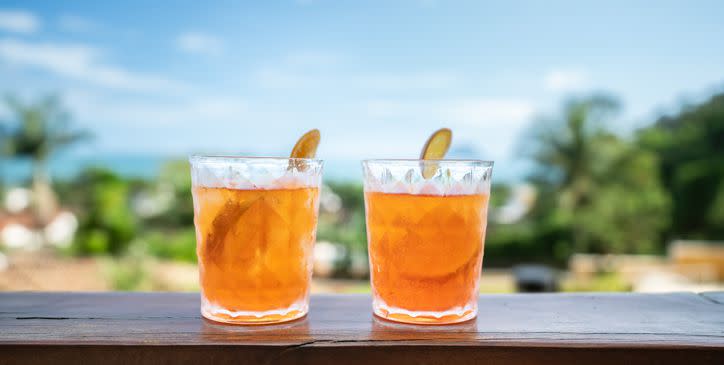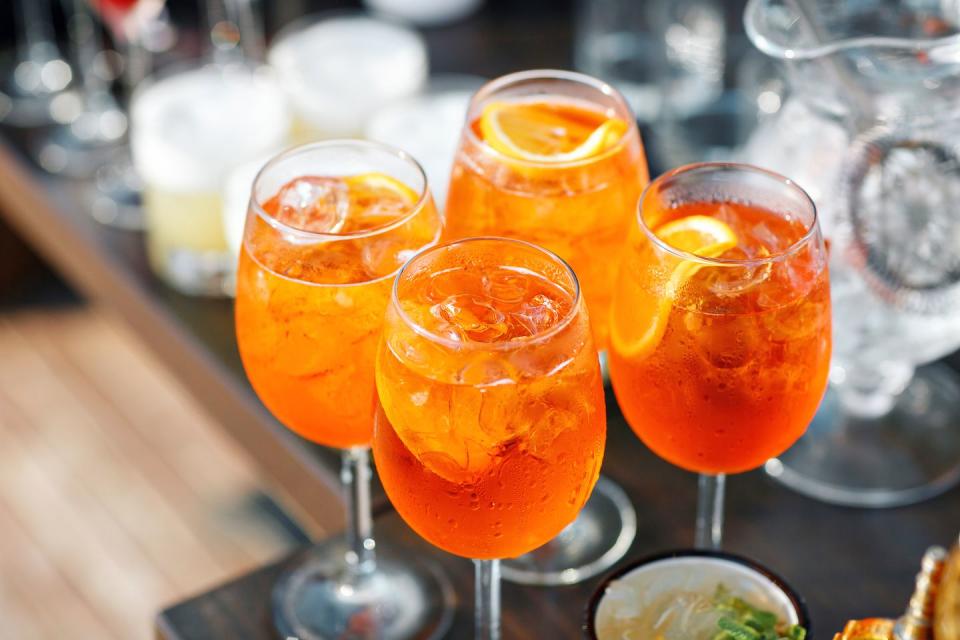Is Aperol a healthy drinks order?

Aperol: "A proprietary name for: an orange-coloured Italian aperitif flavoured with gentian, rhubarb, and a variety of herbs and roots."
That’s right, to mark its 100th birthday – and, more likely, to keep up with its soaring supermarket sales – Aperol, that bright orange aperitif that’s been taking British beer gardens by storm, has officially made it into the Oxford English Dictionary.
According to figures from the Italian-headquartered alcohol company, UK sales of Aperol more than doubled in 2018 – increasing by a whopping 56%. In line with the continuing popularity of Prosecco, which now enjoys around half a billion servings per year (in the UK alone), perhaps?
But, with weather reports starting to tease of summer weather, and Aperol aperitivo season nearly upon us, isn’t it time you got to know exactly how many calories are in an Aperol Spritz and what each serving might look like in terms of its health credentials?
We quizzed The Naked Nutritionist Daniel O'Shaughnessy for his thoughts on the Aperol Spritz.
How many calories in an Aperol Spritz?
Time to hand over to the nutritionist. "There are 125 calories in a standard Aperol Spritz," O'Shaughnessy says. Which, in terms of an Aperol Spritz’s individual parts, looks like what?
60ml Prosecco = 40 calories
35ml Aperol = 85 calories
Soda = 0 calories

What are the health benefits of an Aperol Spritz?
Okay, so don’t be fooled – your summertime tipple is alcoholic, after all. And alcohol brings with it its own host of health drawbacks – cancer, heart disease, diabetes. But, that said, dig deep and you may find your Aperol Spritz contains more benefits than, say, a vodka shot.
O'Shaughnessy gives his take:
1. Aperol is a low-strength spirit
It’s around 11% compared to 40% in standard spirits. So, if you’re trying to cut back from alcohol, this could be better option for you.
2. Aperol tastes bitter
Which is good, why? Well, bitts are good at supporting digestion and stimulate bile.
3. Aperol is made from herbs
The ingredients in Aperol itself, include gentian, rhubarb, and cinchona, amongst others. Herbs and zests yield antioxidant benefits but, whether they would in the small quantities present in an Aperol Spritz, well, that’s a long shot.
But Aperol is alcohol – surely that’s not great for your health?
There’s no getting away from the fact that an Aperol Spritz contains alcohol – both from the Aperol itself, and the Prosecco it’s mixed with. And it’s well documented that alcohol can lead to behaviour changes, cancer (breast cancer, for example, is more common in women who drink excessively), fatigue, osteoporosis, and liver and heart damage.
But, as already mentioned, Aperol is a low-strength spirit so, in terms of how much you’d likely be consuming in one sitting (compared to if you were drinking spirits, for example), your overall intake is likely to be much less. And, as demonstrated by Aperol’s marketing, aperitivo time is a social affair – and the health benefits (think longer life expectancy) of spending time with others, have been scientifically shown.
So what to believe?
As with all alcoholic beverages, consuming in moderation is key. Women are advised to drink no more than 14 units of alcohol per week, according to the NHS, and these should be spread over three or more days.
"There is around 1.5 units in a standard Aperol Spritz," says O'Shaughnessy. "For a completely alcohol-free alternative, try a Seedlip gin; perfect with soda and cucumber."
What’s the best way to make an Aperol Spritz?
You could take your three ingredients (Prosecco, Aperol and soda) and follow the traditional 3:2:1 method. However, there is a move (including from the Aperol team itself) towards doing things 50:50 with just a splash of soda. Garnish with a slice of orange and you’re done.
Looking for a non-alcohol alternative that matches in taste?
"Try Crodinio," says O'Shaughnessy. "Just be aware it acts like a soft drink in terms of its sugar content."
('You Might Also Like',)

